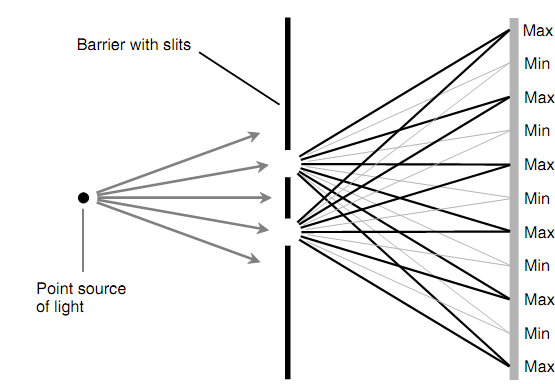Double-Slit Experiments:
When a beam of light gets dim sufficient, its photons originate from the source at intervals which can be measured in seconds, minutes, hours, days, and years. When a beam of light gets brilliant sufficient, its photons rain down at the rate of trillions per second. Such particles can be identified and their energy content determined just as when they were small bullets traveling at 2.99792 x 108 m/s in free space. Though, the particle theory of EM radiation does not elucidate refraction of the kind which takes place at the surface of a body of water. The corpuscular hypothesis also fails to elucidate beating and interference effects which are observed with visible light and high-speed sub-atomic particles. The typical double-slit experiment has been used as an explanation of the wavelike nature of visible light. The below is a somewhat over-simplified explanation of this experiment.
An English physicist named Thomas Young invents an experiment in the hope of solving the particle/wave question. He shown a beam of light containing a certain color and a nearly perfect point source at a barrier with two narrow slits cut in it. Away from the barrier was a photographic film. The light would, Young assumed, pass via the two slits and land on the film, generating a pattern. When light is comprised of corpuscles, then the pattern on the film must to be two bright vertical lines. When light is a train of waves, an interference pattern ought to emerge in the form of alternating bright & dark bands. Whenever the experiment was carried out, the verdict was apparent: Light is a wave disturbance. Interference bands showed up (the figure is as shown below), pointing that the beam was diffracted as it passed via the slits. The troughs and crests from the two diffracted rays alternately added altogether and canceled out as they arrived at different points on the film. This would take place with a wave disturbance though not with stream of corpuscles-or at least not with any kind of particle ever expected up to that time.

Figure: Whenever photons pass via a pair of slits in a barrier, a wave-like interference pattern outcomes.
Though, it had been shown by the other experiments that light has a particle nature. What about the pressure which visible light applies? What about the discovery which its energy can be broken down into certain minimum packets? Is light both a particle and a wave? Or is it somewhat else, something which is really neither though with characteristics of both?
Assume that photons are hurled one by one at a barrier with two slits and are permitted to land on a responsive surface? Experiments of this kind have been completed, and interference bands emerge on the surface no matter how weak the beam. Even when the source is made too dim that only one particle hits the surface every minute, the pattern of light and dark bands emerges after a period of time long sufficient to expose the film (figure is as shown below). This pattern changes based on the distance among the two slits, though it is the similar pattern at all energy intensities.

Figure: How can "wave particles" pass one by one via a pair of slits and still genera an interference pattern?
What occurs in experiments like this? Do photons "know" where to land on the film depend on the wavelength of the light they symbolize? How can a single photon passing via one slit "as certain" the division among the slits, therefore "knowing" where it "can" and "cannot" land on the film? Is it possible that photons divide in two and pass via both slits at the similar time? Does some effect occur backwards in time therefore the photons from the light source "know" about the kind of barrier they are going to have to pass from side to side?
Researchers have a saying: "One theorist can remain a thousand experimentalists tiring." The double-slit experiments illustrate that the converse of this is also true. In the pursuit for knowledge, turnabout is pretty play.